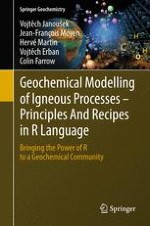The aim of this book is to unlock the power of the freeware R language to advanced university students and researchers dealing with whole-rock geochemistry of (meta-) igneous rocks. The first part covers data input/output, calculation of commonly used indexes and plotting in R. The core of the book then focusses on the presentation and practical implementations of modelling techniques used for fingerprinting processes such as partial melting, fractional crystallization, binary mixing or AFC using major-, trace-element and radiogenic isotope data. The reader will be given a firm theoretical basis for forward/reverse modelling, followed by exercises dealing with typical problems likely to be encountered in real life, and their solutions using R. The concluding sections demonstrate, using practical examples, how a researcher can proceed in developing a realistic model simulating natural systems. The appendices outline the fundamentals of the R language and provide a quick introduction to the open-source R-package GCDkit for interpretation of whole-rock geochemical data from igneous and metamorphic rocks.
